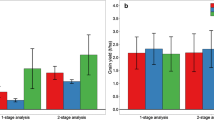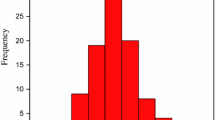Abstract
Studies on genetic gains in grain yield and other traits may be very useful in providing necessary information to plant breeders about the effectiveness of their breeding programs. The objective of this research was to analyze changes in grain yield, yield stability and morphological characteristics of maize hybrids released in Serbia between 1978 and 2011. Five hybrids, representatives of different breeding periods, were chosen for this study. Field trials were conducted during 2013 and 2014 at three locations in Serbia. The estimated genetic gain per breeding period was 440 kg ha−1 which corresponds to an approximate annual linear increase in yield of 63 kg ha−1. Changes in morphological characteristics were presented graphically, compared to the reference value and defined by the third period of breeding. Plant and ear height, kernel row number, number of kernels per row and leaf number were reduced compared to the third breeding period. Kernel depth showed higher variation through periods while in other analyzed traits, major changes in value through the periods were not found. Stability analysis distinguished the hybrids from the sixth and seventh period of breeding as the most stable, whereas the most unstable were representatives of the fifth and third period. Changes in certain morphological traits and yield stability have led to an increase in the genetic potential of the hybrids most probably through the increased tolerance to biotic and abiotic stress factors.




Similar content being viewed by others
References
Badu-Apraku B, Fakorede MAB, Oyekunle M (2014) Agronomic traits associated with genetic gains in maize yield during three breeding eras in West Africa. Maydica 59:49–57
Bradley JP, Knittle KH, Troyer AF (1988) Statistical methods in seed corn product selection. J Prod Agric 1:34–38
Brien CJ (2015) asremlPlus: a collection of functions to augment the use of asreml in fitting mixed models. http://cran.at.r-project.org/web/packages/asremlPlus/index.html
Brown WL (1960) Races of maize in the West Indies. National academies 792. Washington, DC
Bruulsema TW, Tollenaar M, Heckman JR (2000) Boosting crop yields in the next century. Better Crops 84:9–13
Butler DG, Cullis BR, Gilmour AR, Gogel BJ (2010) Analysis of mixed models for S language environments: asreml-R reference manual. Queensland DPI, Brisbane
Cardwell VB (1982) Fifty years of Minnesota corn production: sources of yield increase. Agron J 74:984–990
Ci W, Li M, Liang X, Xie Z, Zhang D, Li X, Lu Z, Ru G, BaiL Xie C, Hao Z, Zhang S (2011) Genetic contribution to advanced yield for maize hybrids released from 1970 to 2000 in China. Crop Sci 51:13–20
Crossa J, Cornelius PL (1997) Sites regression and shifted multiplicative model clustering of cultivar trials sites under heterogeneity of variances. Crop Sci 37:406–415
Duvick DN (1997) What is yield? In: Edmeades GO, et al. (Eds) Developing drought and low N-tolerant maize. Proceedings of a symposium, March 25–29, 1996, CIMMYT, El Batan, Mexico. CIMMYT, México, D.F. pp 332–335
Duvick DN (2005) The contribution of breeding to yield advances in maize. Adv Agron 86:83–145
Duvick DN, Smith JSC, Cooper M (2004) Long-term selection in a commercial hybrid maize breeding program. Plant Breed Rev 24:109–151
Fleischmann R (1942) Jahre maiszuchtung. Z. Fur Pflanzenzuchtung 24:363–373 (In German)
Hadi G (2005) Contribution of the breeding methods used by Rudolf Fleischmann to the development of the Ruma maize heterosis source. Cereal Res Commun 33(2–3):509–516
Hadi G (2006) Maize varieties in Eastern Central Europe in the first decades of the 20th century. Acta Agro Hungarica 54(1):69–82
Ignjatović-Micić D, Ristić D, Babić V, Anđelković V, Marković K, Vančetović J (2013) Genetic assesment of maize landraces from former Yugoslavia. Genetika 45(2):405–417
Ivanović M, Vasić N, Jocković Đ, Stojaković M, Nastasić A (2006) Grain yield of NS maize hybrids representing different eras of breeding. A periodical of scientific research on field and vegetable crops. Institute of Field and Vegetable Crops, Novi Sad 42:15–20 (In Serbian)
Ivanović M, Petrović R, Drinić G, Trifunović V, Kojić L, Vuković M, Mišović M, Radović G, Ristanović D, Pajić Z, Trifunović B, Jelovac D (1995) Fifty years of ZP maize hybrids breeding. Maize breeding, production and utilisation. 50 years of Maize Research Institute, Zemun Polje. Sept 28–29. Belgrade, Yugoslavia, pp 3–16 (In Serbian)
Lang ER, Tavčar A, Trifunović V (1962) Maize of Southeastern Europe and its potential value in breeding programs elsewhere. Euphytica 11:263–272
Lee EA, Tollenaar M (2007) Physiological basis of successful breeding strategies for maize grain yield. Crop Sci 47(S3):S202–S215
Leibman M, Shryock JJ, Clements MJ, Hall MA, Loida PJ, McClerren AL, McKiness ZP, Phillips JR, Rice EA, Stark SB (2014) Comparative analysis of maize (Zea mays) crop performance: natural variation, incremental improvements and economic impacts. Plant Biotechnol J 12:941–950
Ma DL, Xie RZ, Niu XK, Li SK, Long HL, Liu YE (2014) Changes in the morphological traits of maize genotypes in China between the 1950s and 2000s. Europ J Agron 58:1–10
McCullagh P, Nelder JA (1989) Generalized Linear Models, 2nd edn. Chapman and Hall, London
Niu X, Xie R, Liu X, Zhang F, Li S, Gao S (2013) Maize yield gains in Northeast China in the last six decades. J Integr Agric 12(4):630–637
Pavličić J, Trifunović V (1966) Prilog poznavanju nekih značajnijih ekotipova kukuruza gajenih u Jugoslaviji i njihova klasifikacija. Arhiv za Poljoprivredne nauke 19(66):44–62 (In Serbian)
R Core Team (2015) R: A language and environment for statistical computing. R Foundation for Statistical Computing, Vienna
Radić D (1872) Sve o kukuruzu. Društvo za poljsku privredu, Beograd (In Serbian)
Russell WA (1984) Agronomic performance of maize cultivars representing different eras of breeding. Maydica 29:375–390
Russell WA (1974) Comparative performance for maize hybrids representing different eras of maize breeding. In: 29th Ann Corn and Sorghum Res Conf 29. American Seed Trade Association, Chicago pp 81–101
Russell WA (1972) Registration of B70 and B73 parental lines of maize. Crop Sci 12:721
Shull GH (1908) The composition of a field of maize. Rept Am Breeders Assoc 4:296–301
Smith S, Cooper M, Gogerty J, Löffler C, Borcherding D, Wright K (2014) Maize. In: Smith et al (eds) Yield gains in major U.S. field crops. CSSA special publication 33 ASA, CSSA, and SSSA, Madison, pp 125–171
Statistical office of the Republic of Serbia (2015) http://www.webrzs.gov.rs
Stojaković M, Jocković Đ, Bekavac G, Nastasić A, Vasić N, Purar B (2000) Characteristics maize inbred lines originating from local populations. Cereal Res Commun 28(3):299–306
Stojaković M, Ivanović M, Jocković Đ, Vasić N (2007) Characteristics of reselected Mo17 and B73 inbred lines of maize. Maydica 52:257–260
Stojaković M, Ivanović M, Bekavac G, Stojaković Ž (2010) Grain yield of B73 x Mo17-type maize hybrids from different periods of breeding. Cereal Res Commun 38(3):440–448
Stojaković M, Mitrović B, Zorić M, Ivanović M, Stanisavljević D, Nastasić A, Dodig D (2015) Grouping pattern of maize test locations and its impact on hybrid zoning. Euphytica 204:419–431
Stričević R, Djurović N, Djurović Ž (2011) Drought classification in Northern Serbia based on SPI and statistical pattern recognition. Meteorol Appl 18:60–69
Tollenaar M, Lee EA (2002) Yield potential, yield stability and stress tolerance in maize. Field Crop Res 75:161–169
Trifunović V (1978) Maize production and maize breeding in Europe. In: Walden DB (ed) Maize Breeding and Genetics, Wiley New York, pp 41–57
Trifunović V (1986) 40 years of the modern maize breeding in Yugoslavia. In: Proc genetic and breeding of Maize, Belgrade, pp 11–12Dec (In Serbian)
Vančetović J, Mladenović-Drinić S, Babić M, Ignjatović-Micić D, Anđelković V (2010) Maize Genebank collections as potentially valuable breeding material. Genetika 42(1):9–21
Videnović Ž, Dumanović Z, Simić M, Srdić J, Babić M, Dragičević V (2013) Genetic potential and maize production in Serbia. Genetika 45(3):667–677
Wang T, Ma X, Li Yu, Bai D, Liu C, Liu Z, Tan X, Shi Y, Song Y, Carlone M, Bubeck D, Bhardwaj H, Jones E, Wright K, Smith S (2011) Changes in yield and yield components of single-cross maize hybrids released in China between 1964 and 2001. Crop Sci 51:512–525
Yan W (2014) Crop Variety Trials: data management and analysis. Wiley-Blackwell, New York
Yan W, Hunt LA, Sheng Q, Szlavnics Z (2000) Cultivar evaluation and mega-environment investigation based on the GGE biplot. Crop Sci 40:597–605
Zlokolica M, Milošević M, Gerić I (1995) Genetic variability of yugoslav corn collections. Genetika 27(1):63–83
Zuber MS (1973) Registration of 20 maize parental lines. Crop Sci 13:779–780
Acknowledgments
This work was supported by Ministry of Education, Science and Technological Development, Republic of Serbia, through the Project TR1661056. The authors are also grateful to reviewers whose comments and suggestions led to improvement of the manuscript.
Author information
Authors and Affiliations
Corresponding author
Rights and permissions
About this article
Cite this article
Mitrović, B., Stojaković, M., Zorić, M. et al. Genetic gains in grain yield, morphological traits and yield stability of middle-late maize hybrids released in Serbia between 1978 and 2011. Euphytica 211, 321–330 (2016). https://doi.org/10.1007/s10681-016-1739-6
Received:
Accepted:
Published:
Issue Date:
DOI: https://doi.org/10.1007/s10681-016-1739-6




